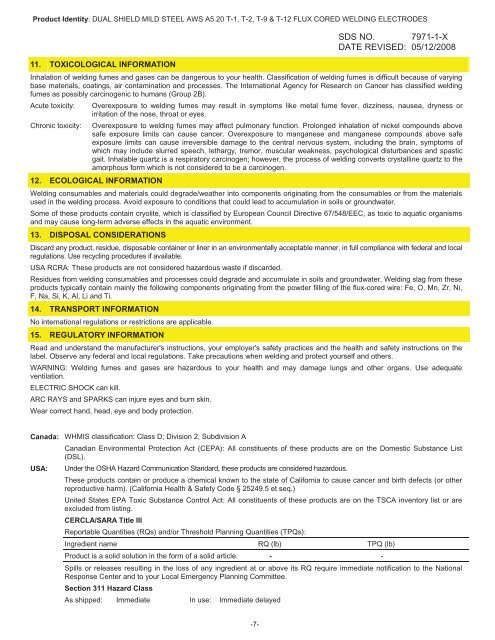Print MSDS - Miller Electric Company Publications
Print MSDS - Miller Electric Company Publications
Print MSDS - Miller Electric Company Publications
You also want an ePaper? Increase the reach of your titles
YUMPU automatically turns print PDFs into web optimized ePapers that Google loves.
Product Identity: DUAL SHIELD MILD STEEL AWS A5.20 T-1, T-2, T-9 & T-12 FLUX CORED WELDING ELECTRODES<br />
-7-<br />
SDS NO. 7971-1-X<br />
DATE REVISED: 05/12/2008<br />
11. TOXICOLOGICAL INFORMATION<br />
Inhalation of welding fumes and gases can be dangerous to your health. Classification of welding fumes is difficult because of varying<br />
base materials, coatings, air contamination and processes. The International Agency for Research on Cancer has classified welding<br />
fumes as possibly carcinogenic to humans (Group 2B).<br />
Acute toxicity: Overexposure to welding fumes may result in symptoms like metal fume fever, dizziness, nausea, dryness or<br />
irritation of the nose, throat or eyes.<br />
Chronic toxicity: Overexposure to welding fumes may affect pulmonary function. Prolonged inhalation of nickel compounds above<br />
safe exposure limits can cause cancer. Overexposure to manganese and manganese compounds above safe<br />
exposure limits can cause irreversible damage to the central nervous system, including the brain, symptoms of<br />
which may include slurred speech, lethargy, tremor, muscular weakness, psychological disturbances and spastic<br />
gait. Inhalable quartz is a respiratory carcinogen; however, the process of welding converts crystalline quartz to the<br />
amorphous form which is not considered to be a carcinogen.<br />
12. ECOLOGICAL INFORMATION<br />
Welding consumables and materials could degrade/weather into components originating from the consumables or from the materials<br />
used in the welding process. Avoid exposure to conditions that could lead to accumulation in soils or groundwater.<br />
Some of these products contain cryolite, which is classified by European Council Directive 67/548/EEC, as toxic to aquatic organisms<br />
and may cause long-term adverse effects in the aquatic environment.<br />
13. DISPOSAL CONSIDERATIONS<br />
Discard any product, residue, disposable container or liner in an environmentally acceptable manner, in full compliance with federal and local<br />
regulations. Use recycling procedures if available.<br />
USA RCRA: These products are not considered hazardous waste if discarded.<br />
Residues from welding consumables and processes could degrade and accumulate in soils and groundwater. Welding slag from these<br />
products typically contain mainly the following components originating from the powder filling of the flux-cored wire: Fe, O, Mn, Zr, Ni,<br />
F, Na, Si, K, Al, Li and Ti.<br />
14. TRANSPORT INFORMATION<br />
No international regulations or restrictions are applicable.<br />
15. REGULATORY INFORMATION<br />
Read and understand the manufacturer's instructions, your employer's safety practices and the health and safety instructions on the<br />
label. Observe any federal and local regulations. Take precautions when welding and protect yourself and others.<br />
WARNING: Welding fumes and gases are hazardous to your health and may damage lungs and other organs. Use adequate<br />
ventilation.<br />
ELECTRIC SHOCK can kill.<br />
ARC RAYS and SPARKS can injure eyes and burn skin.<br />
Wear correct hand, head, eye and body protection.<br />
Canada: WHMIS classification: Class D; Division 2, Subdivision A<br />
Canadian Environmental Protection Act (CEPA): All constituents of these products are on the Domestic Substance List<br />
(DSL).<br />
USA: Under the OSHA Hazard Communication Standard, these products are considered hazardous.<br />
These products contain or produce a chemical known to the state of California to cause cancer and birth defects (or other<br />
reproductive harm). (California Health & Safety Code § 25249.5 et seq.)<br />
United States EPA Toxic Substance Control Act: All constituents of these products are on the TSCA inventory list or are<br />
excluded from listing.<br />
CERCLA/SARA Title III<br />
Reportable Quantities (RQs) and/or Threshold Planning Quantities (TPQs):<br />
Ingredient name RQ (lb) TPQ (lb)<br />
Product is a solid solution in the form of a solid article. - -<br />
Spills or releases resulting in the loss of any ingredient at or above its RQ require immediate notification to the National<br />
Response Center and to your Local Emergency Planning Committee.<br />
Section 311 Hazard Class<br />
As shipped: Immediate In use: Immediate delayed



